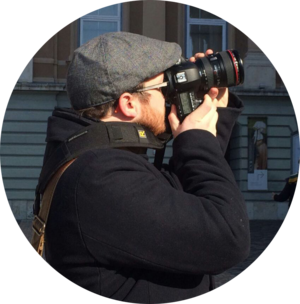Story Behind the Photo: Star Trail over Loch Garten
DRL Photography is a participant in the Amazon EU Associates Program, an affiliate advertising program designed to provide a means for sites to earn advertising fees by advertising and linking to Amazon.co.uk
Earlier this year, I had seen a lot of astrophotography pictures on social media, like Twitter and Pinterest and I decided to do some research into how the hell photographs like that are made.
My first port of call was to look on Amazon and find a couple of books on the subject. The one that I ended up purchasing and which has been an invaluable resource moving forward was easily Dusk to Dawn by Glenn Randall (Affiliate Link).
It’s a brilliant book that gives guidance on most landscape photography taken at night, including sections on capturing the Milky Way, creating star trails, photographing the Aurora Borealis and many more subjects. All in all a very intriguing book.
My immediate interest was Star Trails as it not only creates a dramatic effect, star trail images also manage to demonstrate the passage of time.
In other words you are able to capture not only the 3 dimensions of physical space but the fourth dimension that is intrinsic to everyone. I avidly read and re-read the section about star trails until I created a plan.
To do star trails you require a piece of equipment that I lacked at the time, an Intervalometer. This handy little gadget acts as an automatic controller for your camera, you set how long the exposure is and how much time you want to pass between each exposure, and how many exposures you want to create the effect that you are after.
There is a handy app on the phone that can help you calculate all of this, called Photo Pills, it’s paid but it has a lot of features that can be really useful.
Now that I knew I needed this bit of kit, I went back on Amazon and I bought this one (Affiliate Link). Learning to use this new bit of kit was fairly easy, although the manual is a bit complicated , Glenn’s book helps you work it out by introducing the most important functions.
Now I had the kit, all that I needed was a clear night and in Scotland, as you can imagine, that’s not the easiest thing to achieve.
I vigilantly watched the weather forecast, and as it was winter I knew that the nights were longer and darker so all the better!
A week or two after my intervalometer arrived, I was blessed by a clear forecast.
The other factor that one must calculate when looking at the night sky is the moon. In the dark, the moon can create a ridiculous amount of light! Luckily on this particular night, the moon rise was not until 2 or 3 in the morning.
I calculated I would need roughly 100 exposures at 1 minute each with a 1 minute interval. I decided to try my luck at Loch Garten which, as it is a nature reserve and there are no major towns nearby, I thought that it would have a sufficiently dark night sky.
I left home at 11 o’clock and it was bloody freezing! -3 degrees Celsius roughly!
I had several layers on but it was still cold, and the worst part with the cold is that your nose always feels like a block of ice. Stuffy, cold and hard, and the only way I can think to keep your nose warm is with a balaclava. I’ve tried scarves and neck warmers brought up over my nose but as I wear glasses that leads to a bit of a visibility issue!
I arrived at the Loch Mallachie car park and made my way down to the shores of Loch Garten using my very handy Petzl Actik Head Torch (Affiliate Link) to find my way through the forest on a dark night.
I found my composition where there are 3 large boulders sticking up out of the loch, the only issue with them is that you cannot get any separation but I personally like their layered appearance.
I set everything up, plugged in the intervalometer and left it going. That was it. Simple!
While I waited for the camera to do what it needed to I just kept wandering around the forest, trying to keep myself warm. Every now and again I would stop and sit down by the loch but it was so cold, I needed to keep moving to stop myself from shivering.
The loch was actually freezing as I sat there, so I knew it was getting colder as the night drew on.
I heard some very strange noises coming from around the forest and what I perceived to be the loch itself. Very guttural, unlike anything I had heard before. Now as you can imagine, in the dark, on my own, my imagination for a split second leapt away from me and I panicked a little bit wondering what the hell the noise was.
After a couple minutes of me trying to decide what to do, my rational mind returned and I listened with curiosity rather than fear. I believe that what I was hearing was in fact the oft quiet and cautious Roe Deer, but I need to hear it properly again to be sure.
After 2 hours I had finished the 100 exposures and decided to have a quick go at a second shot before my batteries died from the cold.
I recomposed the image in a different way set the intervalometer again, and left it.
It was now 1 in the morning and I was getting seriously cold. Anyone who has spent time in proper cold will know what I mean. Although I was wearing a hat and several hoods, my forehead started to hurt, my nose was hurting, my teeth even began to hurt from the cold air I was breathing.
I gave it another hour but I decided to cut the second image a little short, as I was so cold. When I got back to my car I found that the temperature was lower than -10 degrees Celsius, no wonder I was so cold!
The next day I imported the images and used a nifty photoshop script written by Floris van Breugel that was recommended in Glenn’s book to stack and blend the images.
Surprisingly it took a couple hours for photoshop to run the program, but at the end of it I had a beautiful star trail picture!
Or so I thought at the time!
As I examined the pictures, I noticed that actually I had missed the focal point on my distant mountains. I had opened the focus too far and that led to the mountains being slightly blurred around the edges.
Unfortunately I haven’t had another go at astrophotography since. I’m hoping for some nice clear nights this winter, but we will have to see whether Scottish weather plays ball!
These pictures were taken with my Canon 5D mark III (affiliate link) no longer in production I would recommend the Canon 5D mark IV instead, Canon 17-40mm f4 L at 17mm and 40mm (affiliate link), Intervalometer (affiliate link) and 3 Legged Thing Winston Carbon Fibre Tripod (affiliate link). The exposure for the top image was 100 images at 1 minute with a 1 minute interval, and the bottom one was 50 images of 1 minute and 1 minute interval, both at f/4 and ISO 200.
Related Articles
Written by Daniel Long
Daniel Long created DRL Photography as a place to showcase his work as a photographer. Daniel has learnt a lot about photography and wishes to impart this knowledge with you, although the world is an ever changing place and he always says “you can never learn everything.” So as he makes his way, he continues to learn knew techniques, skills and information about photography. He focuses on Landscape and Wildlife photography and Daniel has a special focus on Scotland, his home away from home. As well as writing about photography and taking pictures out in the field, Daniel offers guided photography days so he can share his knowledge and locations in an effort to give his clients the best opportunities possible. Have a browse around this website to see his images, guided experiences and articles about photography. If you have any questions don’t hesitate to get in contact.

















